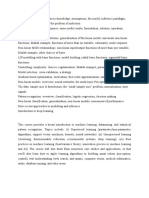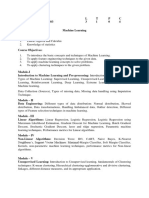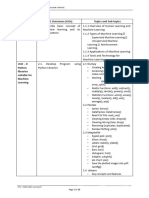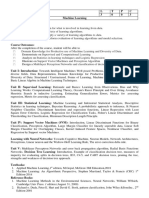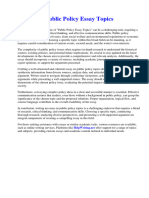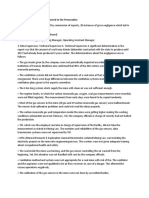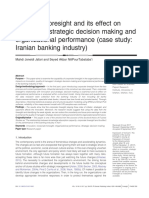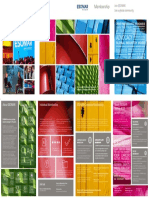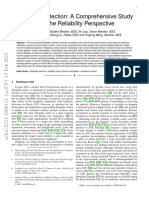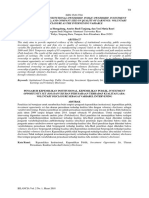Subject Name: Introduction to Machine Learning
Subject Code: MCA240304
Credits: 4
Course Objectives:
1. To understand the foundational concepts of Machine Learning.
2. To develop supervised learning models for regression, including performance
evaluation.
3. To analyze and implement various classification techniques and ensemble methods
to solve real-world problems.
4. To explore unsupervised learning techniques like clustering and dimensionality
reduction for discovering hidden patterns in data.
5. To gain knowledge of association rule learning and understand how to extract
meaningful relationships from large datasets.
Course Outcomes:
At the end of the course, students will be able to:
CO1: Apply fundamental ML concepts and Python libraries to preprocess data for
machine learning applications.
CO2: Develop and evaluate regression models using various techniques
CO3: Implement various classification algorithms and assess their
performance using appropriate evaluation metrics.
CO4: Use clustering and dimensionality reduction methods to organize and analyze
high-dimensional datasets effectively.
CO5: Apply association rule learning techniques to uncover hidden patterns in data.
No of
Unit
Topics lecture
No.
Hours
Foundational Concepts of Machine Learning
1.1 Overview, Applications
1
1.2 Traditional Programming Vs. Machine Learning 14
1.3 Difference between Data Science, Artificial
25
� Intelligence, Machine Learning and Deep Learning
1.4 Types of ML: Supervised, Unsupervised, and
Reinforcement Learning
1.5 Bias, Variance, Underfitting, Overfitting
1.6 Machine Learning Life Cycle
1.7 Data Preprocessing
1.8 Programming for Machine Learning- Python
Libraries NumPy, Pandas, Matplotlib, Scikit-learn
Supervised Learning Algorithms - I
2.1 Introduction to Regression Analysis
2.2 Simple Linear Regression
2
2.3 Multiple Linear Regression 13
2.4 Polynomial Regression
2.5 Evaluation Metrics for Regression
Supervised Learning Algorithms - II
Introduction to Classification Analysis
K - Nearest Neighbors (KNN)
Logistic Regression
3
Naive Bayes Theorem 12
Support Vector Machine
3.6 Decision Tree Classification
3.9 Evaluating Classification Models
Unsupervised Learning Algorithms - I
4.1 Introduction to Clustering
4 4.2 Types of Clustering
11
4.3 K-Means Clustering
4.4 Hierarchical Clustering
Unsupervised Learning Algorithms – II
5.1 Introduction to Association Rule Mining
5.2 Market Basket Analysis
5
5.3 Key Terms - Support, Confidence, and Lift 10
5.4 Apriori Algorithm
5.5 FP- Growth Algorithm
26
�Text Books:
1. Raschka, S., & Mirjalili, V. (2022). Python machine learning: Machine
learning and deep learning with Python, scikit-learn, and TensorFlow 2
(3rd ed.). Packt Publishing.
2. Bishop, C. M. (2006). Pattern recognition and machine learning.
Springer.
3. Shalev-Shwartz, S., & Ben-David, S. (2014). Understanding machine
learning: From theory to algorithms. Cambridge University Press.
4. Alpaydin, E. (2020). Introduction to machine learning (4th ed.). MIT
Press.
Reference Books:
1. Géron, A. (2022). Hands-on machine learning with Scikit-Learn, Keras,
and TensorFlow: Concepts, tools, and techniques to build intelligent
systems (3rd ed.). O'Reilly Media.
2. Goodfellow, I., Bengio, Y., & Courville, A. (2016). Deep learning. MIT
Press.
Web Resources:
1. Introduction to Machine Learning - Course Available at:
https://onlinecourses.nptel.ac.in/noc23_cs18/preview
2. Machine Learning And Deep Learning - Fundamentals And Applications -
Course Available at:
https://onlinecourses.nptel.ac.in/noc23_ee87/preview
3. Machine Learning for Engineering and Science Applications - Course
Available at: https://onlinecourses.nptel.ac.in/noc19_cs82/preview
Journals:
1. Journal of Machine Learning Research Available at: https://www.jmlr.org/
27



